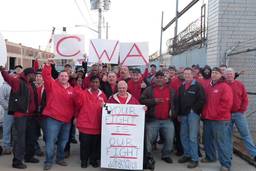In the premier episode of the latest season of the hit show Mad Men, set in 1966, advertising executive Roger Sterling says that an Oldsmobile executive was “looking to know if there is a way around Nader.” In an interview with In These Times this week, Ralph Nader laughed, saying, “They are very accurate, They were very worried about me.”
Now 46 years later — and 47 years after publication of his book Unsafe at Any Speed, which detail auto companies unwillingness to spend money on safety features — Ralph Nader has a new target in his pursuit of safety issues — the AFL-CIO. Nader claims that in recent years the AFL-CIO hasn’t done enough to pressure the White House on workplace safety issues.
“Obama spends more time figuring out bracket wins in the NCAA basketball tournament than he spends thinking about OSHA,” says the 78-year-old. “This is the fault of organized labor, they haven’t forced it into the political arena.”
Nader claims that Cass Sunstein, who heads up the Office of Information and Regulatory Affairs within the OMB, has blocked many regulations out of fear that they would hurt industry. “They appointed an excellent person to run [the Occupational Safety and Health Administration] — David Michaels. The person, though, who is really running OSHA is Cass Sunstein,” Nader says. “It’s designed to be fairly independent, and it’s become a puppet of OMB.”
Many workplace safety advocates have been disappointed with progress by OSHA under President Obama. The implementation of two major rule changes — which would limit worker exposure to carcinogenic silica dust and prohibit children from working in dangerous farm occupations — has been significantly delayed by the Office of Management and Budget, the federal agency that oversees and gives final approval to any regulatory changes.
Nader says that he’s frustrated after having talked with AFL-CIO President Richard Trumka and his staff about pushing Obama more on workplace safety. “He’s very good when you talk to him in private, but it’s in the doing. When you talk to [the AFL-CIO] they talk tough. It seems like you are talking to Eugene Debs,” says a frustrated Nader.
Recently, Nader sent AFL-CIO President Richard Trumka an open letter urging him to critique the president more strongly on a number of areas, from workplace safety to raising the minimum wage. “Their performance is pretty lackadaisical. Publicly, they endorse Obama with no quid pro quos. The only promise was one way — $400 million from the AFL-CIO [to support the president’s re-election campaign]. He’s got them in their pocket and he knows it,” says Nader.
The AFL-CIO dismisses the longtime activist and four-time presidential candidate’s complaints.
“Unfortunately Ralph Nader seems more intent on holding on to his celebrity by publicly criticizing others rather than quietly committing to doing the work necessary to rebuild a better country for everyone,” says AFL-CIO spokeswoman Allison Omens. “We wish him luck in his endeavors”
Nader blames the AFL-CIO for not pushing workplace safety harder, but the problem may have more to do with that fact that many unions with decreasing budgets (caused by decreasing membership) have cut back staff dedicated to workplace safety issues.
“There were once very large health and safety department at the AFL-CIO and at individual unions 10 years ago, and they started declining,” says Tom O’Connor, executive director of the National Council for Occupational Safety and Health. “The most dramatic example is that SEIU went from 24 to just a handful in a decade.”
SEIU Workplace Safety Director Occupation Health and Safety Director Bill Borwegen says that the moves were necessary to save the union. Borwegen says that even with a smaller staff the union has been able to incorporate workplace safety programs throughout the union and has trained more people at the local level to work on workplace safety.
“There was a point about 15 year ago where they were putting too many resources into workplace safety and not enough into organizing. People were wondering if unions would (still) be around. So they took some of those people from health and safety and put them into organizing,” says Borwegen. “If it wasn’t for this, I would be with a smaller union, but one that had a very large safety and health department. I don’t begrudge Andy Stern because he took some of my best people, because we have done some remarkably work in terms of organizing in the last 15 years.”
O’Connor says workplace safety and organizing shouldn’t be seen as mutually exclusive: “Workers care about health and safety more than any other issues. People that are health and safety experts can be seen as good organizers. I think it’s unfortunate that it’s seen as a trade-off in terms of resources between these two different issues.”
Indeed a 2010 poll by National Opinion Research Center at the University of Chicago done for the Public Welfare Foundation found that 85 percent of workers ranked safety as most important labor standard that workers care about. (Full disclosure: the Public Welfare Foundation supports In These Times.) The survey showed that workers find health and safety more important than wage standards, overtime pay or the right to join a union.
Nader says OSHA’s lethargy under the Obama administration is symptomatic of a deeper problem: organized labor being too captive to the Democratic party.
“Without the AFL-CIO and labor, [Obama] wouldn’t be president. If they signal to them that they can be taken, labor will be taken. This nowhere-to-go syndrome is destroying the whole left political spectrum completely. All the GOP has to do is get worse and the Democrats get worse, because that’s where the money is,” Nader says.








